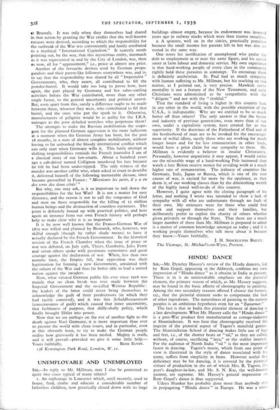HINDU DANCE SIR, Mr. Dyneley Hussey's review of the Hindu
dancers, led by Ram Gopal, appearing at the Aldwych, confirms my own impression of " Hindu dance " as it obtains in India at present. There is in it an unmistakable emphasis on the pictorial element, the primary reason of which, as Mr. Hussey suggests, may be found in the basic affinity of choreography to painting. Among the two secondary reasons offered I choose the former, viz., that the pictorial element seeks to compensate the lack of other ingredients. The naturalness of painting to the eastern peoples is an ambitious hypothesis even for an "Easterner."
The fact is that in India this pictorial element of dancing is a late development. What Mr. Hussey calls the " Hindu dance " is a post-War product first manufactured as cottage-industry at Shantiniketan. It was here that choreography received the imprint of the pictorial aspect of Tagore's manifold genius. The Shantiniketan School of dancing makes little use of legs and feet, i.e., of the shorter beats or " tal," as they are called, without, of course, sacrificing " laya," or the stabler interval. For the audience of North India " tal " is the most important factor in dancing. Tagore's music, which from one point of view is illustrated in the style of dance associated with his name, suffers from simplicity in beats. However useful this deficiency may be for dancing, it is covered by the pictorial virtues of production in the art of which Mrs. R. Tagore, the poet's daughter-in-law, and Mr. S. N. Kar, the well-known painter, are supreme. Mr. Hussey's general impression on Ram Gopal's dance is thus supported.
Udaya Shankar has probably done more than anybody else in propagating " Hindu dance " in Europe. He was a com- potent pupil of Sir W. Rothenstein, and the legend is that the latter fought with Anna Pavlova over his soul and body. Udaya Shankar's pictorial sense is highly developed. Thus between Tagore and Udaya Shankar the bias was first created. Others have only underlined it.
My experience of pre-neo-Hindu dance in its original settings, however, does not corroborate Mr. Hussey's impres- sion. Leaving aside the Lucknow " Kathak " school, which may not be purely Hindu, but Hindu-Muslim, though its greatest masters were and have been Hindus, the original settings of " Hindu " dance are either of the village-scene or of the temple. Of course, for the spectator such backgrounds, being panoramic, are pictorial in a sense. But in the dance proper the dominant element is always the sculptural. The transition is invariably from one sculpturesque pose to another, stress being laid on planes and volumes. In fact, the transition is seldom filled up by movements as one finds in the ballet. Mr. Hussey must have noticed how Udaya Shankar and Ram Gopal eliminate movement in their moments of supreme ecstasy, as in Shiva or Bodhisatva dance. The best male dancers of Southern India vie with one another in imita- ting the varied types of Tandava sculpture. Women temple dancers pay the same high compliment to Dipaluxmi figures. It must be confessed that modern " Hindu " dance is losing the sense of sculpture, though it has gained in the pictorial. I put it down to western influence.
Mr. Hussey is only partly right when he says that the strict conventions of Hindu dance restrict the artist. In the first place, there is little or no restriction regarding the assemblage of " mudras." There are only a few shastric injunctions on movements which connect them. So any such limitation as Mr. Hussey mentions is neither more nor less than what is imposed upon a sentence by words. The Hindu Shastras on dancing are only dictionaries of words and not the grammar of their syntax. In the second place, there are hundreds of such " mudras " to select from. This means freedom for the artist.
What Mr. Hussey says about costumes is quite correct. In the remotest villages and among primitive tribes I have seen costumes which would put to shame the Rue de La Paix and Bond Street.
As an Indian, I cannot but be gratified by Mr. Hussey's review. Speaking again as an Indian, I do not like the phrase "Hindu " dance. What Mr. Hussey has seen is modern Indian dance done by artists from Southern India.—Yours



































 Previous page
Previous page